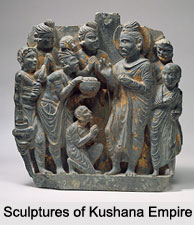 Sculptures of Kushana Empire, especially those which belonged to the Gandhara region show a strong influence of Greek and Roman elements. Its images wear toga-like garments and have wavy hair and straight Roman noses. Sculpture is usually created from dark gray phyllite, schist, stucco, or terracotta.
Sculptures of Kushana Empire, especially those which belonged to the Gandhara region show a strong influence of Greek and Roman elements. Its images wear toga-like garments and have wavy hair and straight Roman noses. Sculpture is usually created from dark gray phyllite, schist, stucco, or terracotta.Sculpture of southern Mathura region was developed from indigenous Indian traditions, emphasizing rounded bodily forms. Its voluptuous sculptural images wear minimal garments and are usually carved from red mottled sandstone. During the Kushan period Mathura produced art for the Jains and the Hindus as well.
History of the Sculptures of Kushana Empire
The Kushans, ancestry of migrants from different parts of Central Asia, settled in present-day northern India. There were two artistic centres of the Kushan Empire, each with a characteristic style: a northern one in the Gandhara area centred in the region of Peshawar and later in Taxila and a southern one in Mathura, south of current-day New Delhi. It was under the Kushan rulers that the Gandhara School of Art developed. During the time of Kushans, Lord Buddha was first shown in human form in this region.
For more, visit the link below: